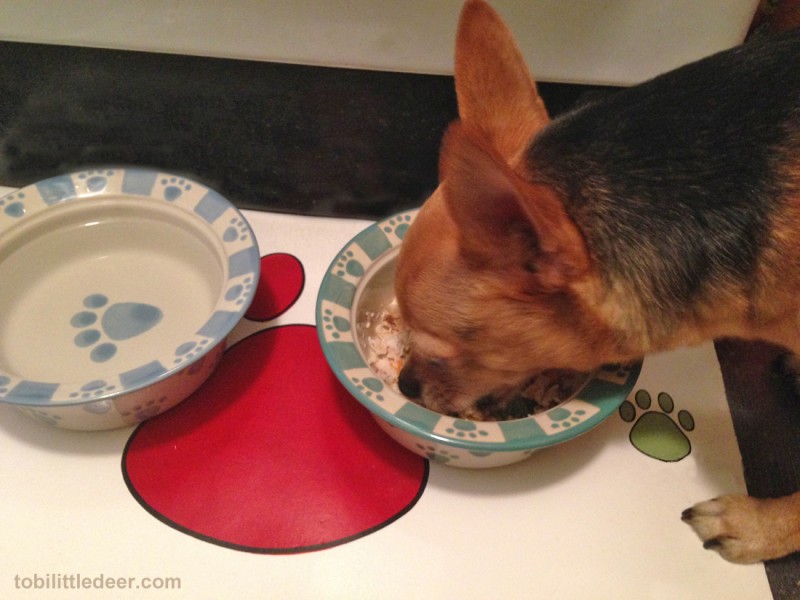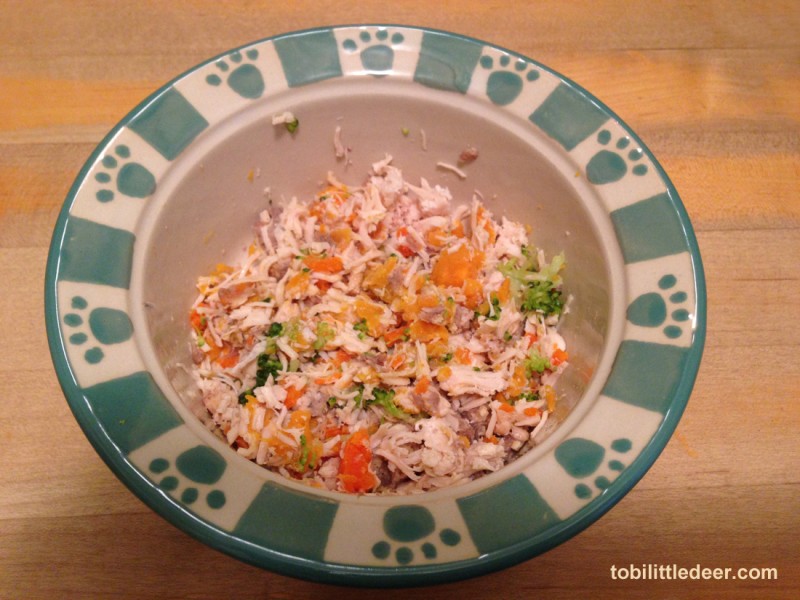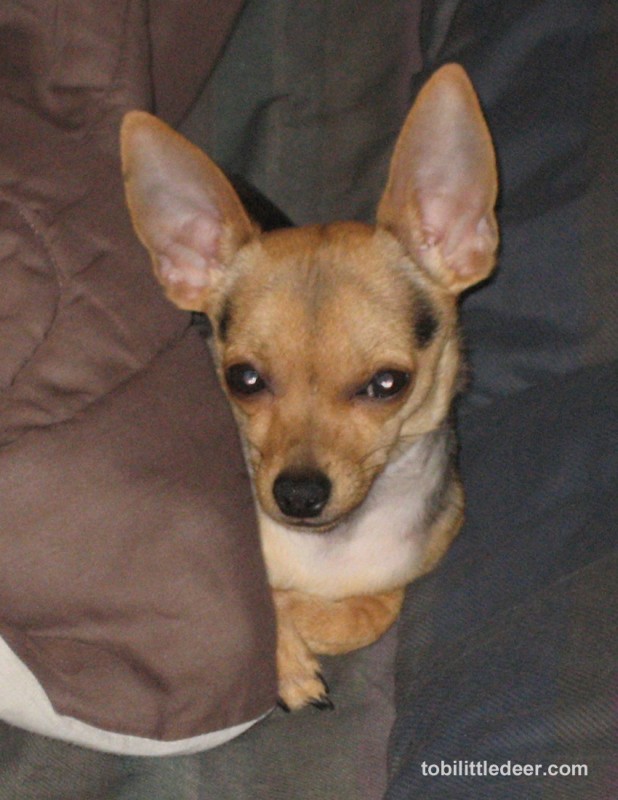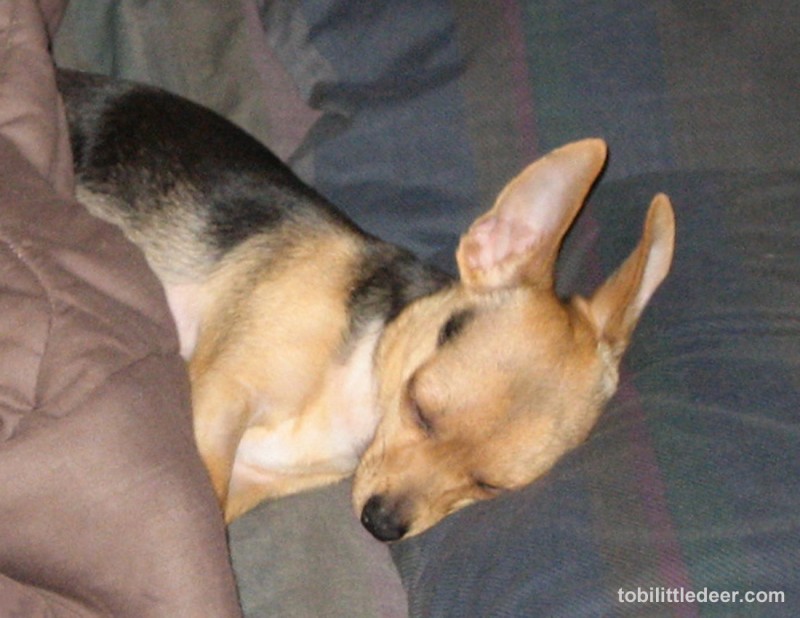
When Ted sees a commercial touting how much beef or chicken this or that dog food contains, he says, “I don’t buy dog food and hope for chicken. If I want my dog to eat chicken, I feed him chicken.” Ted knows every ingredient I am eating because he’s the one who prepares my food for me.
The basis of my morning breakfast and evening dinner is chicken. Ted buys it in cans, already cooked, at Costco. He opens a can, pours the contents into a colander (that’s a bowl with holes), and runs cold water over it to rinse it well. Then, putting my dish onto a kitchen scale, he weighs an ounce of the chicken into it. The balance is stored in a glass container in the refrigerator. Each time Ted takes an ounce from it for me, he weighs the amount into my ceramic food dish, then warms it in the microwave for eight seconds. Afterwards he touches his finger to whatever he warms for me to make sure it is the right temperature.
When Ted is asked, “You cook for your dog?” he answers, “Well, not exactly; I microwave.”
The amount of food Ted gives me each day is based on my body weight of nine pounds, and the fact I get a lot of exercise. Ted says to me, “You like to eat, you’ve got to run.” We jog before breakfast for forty-five minutes every morning. So I’m muscular, but I don’t get fat.
My breakfast comes in two courses. The first is the ounce of chicken, with my dog-multi-vitamin sprinkled onto it. Meanwhile Ted is cooking a mixture of oat meal/oat bran (50% of each) for both of us, and my second course is an ounce of that mixed into two ounces of warm milk. (The hot oatmeal usually warms the milk sufficiently. However, if needed, Ted puts the oatmeal and milk into the microwave for five seconds. Before giving it to me, he always tests the temperature with his finger-tip.)
At lunch-time Ted puts a small dab (a flat teaspoon) of plain non-fat yogurt into my dish—I prefer Greek yogurt—along with a tablespoon of whatever no-added-salt soup he is having. It’s not a meal, but just a tide-me-over.

In the evening we have dinner. I get another ounce of chicken, with a half-ounce of cooked pink wild-Alaska salmon added to it. Ted buys the salmon already cooked in cans, and cleans it well, removing the skin and larger bones. (Note: Dogs should never be given raw salmon because of a bacterium in it harmful to them, but cooked salmon is fine.) Then Ted adds to the chicken and salmon three-quarters ounce combined of three vegetables he is having. Typical ones are sweet potato, carrots, and broccoli, cut up into chunks and microwaved in a bit of water that is poured off afterwards. No spices or sauces, just the unadulterated tastes of the vegetables themselves. I get a chunk of each, and I particularly like the broccoli. If Ted is having corn on the cob, he cuts off a few kernels for me. Ted breaks up with a spoon this mixture of chicken, salmon and vegetables. Usually the heat of the vegetables warms the whole mix, but after the finger-tip test, if Ted feels it is not warm enough, he puts my ceramic dish with its contents into the microwave for five seconds. After he warms it, he mixes into it a teaspoon of virgin olive oil (which makes my fur lustrous). That’s my dinner. I “wolf it down” and lick my dish clean.
Then I wait for Ted to finish his own dinner, because that’s when he takes out the vanilla ice cream. He says he buys it for me, but he always enjoys some, too. When I see him open the freezer I whine in anticipation and spin in circles I’m so happy. He gives me a level teaspoon of vanilla ice cream each evening into my dish for dessert. It’s cold, but I “wolf” it, too.
That’s the Tobi Little Deer diet. No ingredients regulated unfit for human consumption; no fads. Just chicken for chicken, salmon for salmon, whole grains and fresh vegetables—followed by a dab of vanilla ice cream. With that nutrition, combined with lots of exercise, particularly our morning jog, I am a very healthy dog with lots of stamina.
© 2014 Woodwrit, Inc.

